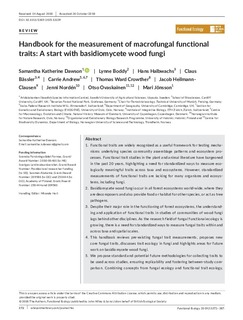| dc.contributor.author | Dawson, Samantha Katherine | |
| dc.contributor.author | Boddy, Lynne | |
| dc.contributor.author | Halbwachs, Hans | |
| dc.contributor.author | Bässler, Claus | |
| dc.contributor.author | Andrew, Carrie Joy | |
| dc.contributor.author | Crowther, Thomas Ward | |
| dc.contributor.author | Heilmann-Clausen, Jacob | |
| dc.contributor.author | Nordén, Jenni | |
| dc.contributor.author | Ovaskainen, Otso | |
| dc.contributor.author | Jönsson, Mari | |
| dc.date.accessioned | 2019-03-07T12:42:50Z | |
| dc.date.available | 2019-03-07T12:42:50Z | |
| dc.date.created | 2019-03-04T15:07:30Z | |
| dc.date.issued | 2018 | |
| dc.identifier.citation | Functional Ecology. 2018, 1-16. | nb_NO |
| dc.identifier.issn | 0269-8463 | |
| dc.identifier.uri | http://hdl.handle.net/11250/2589194 | |
| dc.description.abstract | Functional traits are widely recognized as a useful framework for testing mechanisms underlying species community assemblage patterns and ecosystem processes. Functional trait studies in the plant and animal literature have burgeoned in the past 20 years, highlighting a need for standardized ways to measure ecologically meaningful traits across taxa and ecosystems. However, standardized measurements of functional traits are lacking for many organisms and ecosystems, including fungi.
Basidiomycete wood fungi occur in all forest ecosystems world‐wide, where they are decomposers and also provide food or habitat for other species, or act as tree pathogens.
Despite their major role in the functioning of forest ecosystems, the understanding and application of functional traits in studies of communities of wood fungi lags behind other disciplines. As the research field of fungal functional ecology is growing, there is a need for standardized ways to measure fungal traits within and across taxa and spatial scales.
This handbook reviews pre‐existing fungal trait measurements, proposes new core fungal traits, discusses trait ecology in fungi and highlights areas for future work on basidiomycete wood fungi.
We propose standard and potential future methodologies for collecting traits to be used across studies, ensuring replicability and fostering between‐study comparison. Combining concepts from fungal ecology and functional trait ecology, methodologies covered here can be related to fungal performance within a community and environmental setting.
This manuscript is titled “a start with” as we only cover a subset of the fungal community here, with the aim of encouraging and facilitating the writing of handbooks for other members of the macrofungal community, for example, mycorrhizal fungi. | nb_NO |
| dc.language.iso | eng | nb_NO |
| dc.publisher | British Ecological Society | nb_NO |
| dc.rights | Navngivelse 4.0 Internasjonal | * |
| dc.rights.uri | http://creativecommons.org/licenses/by/4.0/deed.no | * |
| dc.title | Handbook for the measurement of macrofungal functional traits: A start with basidiomycete wood fungi | nb_NO |
| dc.type | Journal article | nb_NO |
| dc.type | Peer reviewed | nb_NO |
| dc.description.version | publishedVersion | nb_NO |
| dc.source.pagenumber | 1-16 | nb_NO |
| dc.source.journal | Functional Ecology | nb_NO |
| dc.identifier.doi | 10.1111/1365-2435.13239 | |
| dc.identifier.cristin | 1682157 | |
| dc.description.localcode | © 2018 The Authors. Functional Ecology published by John Wiley & Sons Ltd on behalf of British Ecological Society. This is an open access article under the terms of the Creative Commons Attribution License, which permits use, distribution and reproduction in any medium, provided the original work is properly cited. | nb_NO |
| cristin.unitcode | 194,63,15,0 | |
| cristin.unitname | Institutt for matematiske fag | |
| cristin.ispublished | true | |
| cristin.fulltext | original | |
| cristin.qualitycode | 2 | |

